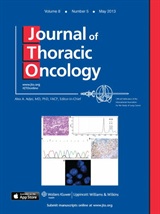J Thorac Oncol:所有肺腺癌患者应检测基因
2013-04-16 佚名 医师报
4 月3 日,美国病理学家学点评院、国际肺癌研究学会和美国分子病理学学会三大权威学术机构发布肺癌分子学检测指南,建议所有肺腺癌患者接受基因检测,以便选择靶向治疗药物,例如表皮生长因子受体(EGFR)抑制剂(如厄洛替尼和吉非替尼)和间变性淋巴瘤激酶(ALK)酪氨酸激酶抑制剂(例如克里唑蒂尼)。(Arch Pathol Lab Med.
4 月3 日,美国病理学家学点评院、国际肺癌研究学会和美国分子病理学学会三大权威学术机构发布肺癌分子学检测指南,建议所有肺腺癌患者接受基因检测,以便选择靶向治疗药物,例如表皮生长因子受体(EGFR)抑制剂(如厄洛替尼和吉非替尼)和间变性淋巴瘤激酶(ALK)酪氨酸激酶抑制剂(例如克里唑蒂尼)。(Arch Pathol Lab Med. JMol Diagn. J Thorac Oncol. 2013年4 月3 日在线版)
循证医学证据提示,肺癌患者如果进行基因检测并选择合适的靶向治疗药物,其预后会明显改善。因此,指南建议,所有肺腺癌患者不论性别、种族、是否吸烟或伴其他临床危险因素,均应接受基因检测,其中EGFR突变和ALK 融合是首选检测项目。指南强调,原发肿瘤和转移病变同样适合检测EGFR 和ALK 状态。EGFR 和ALK 检测不适用于非腺癌肺癌患者,包括单纯鳞状细胞癌、单纯小细胞癌和免疫组织化学检测缺乏腺癌分化证据的大细胞肺癌患者。EGFR 和ALK 状态检测时机为:适合治疗的晚期肺癌患者确诊时;既往肺癌分期较早但未接受基因检测的患者疾病复发或进展时。
作者指出,社区基层医院的观点倾向于,吸烟的肺腺癌患者进行基因检查是一种浪费。事实上,这种观点是错误的,5%~10%的吸烟肺腺癌患者基因检测阳性,因此能从靶向治疗中获益。
美国国家犹太健康医院James Jett 指出,该指南会改善大量肺癌患者的预后。肺腺癌是肺癌中最常见的类型,占60%~70%。约15% 的肺腺癌患者为EGFR 突变患者,5% 为ALK 突变患者。Jett 强调,该指南很适合Ⅳ期肺癌这一类“能治疗但不能治愈的疾病”。在不治疗的情况下,晚期肺癌患者的中位生存期仅4~5 个月,标准化疗可将生存期延长至9 个月,而EGFR 抑制剂能将生存期延长至2 年。此外,靶向治疗药物通常是口服药,其毒性低于化疗药物,因此接受该类药物治疗的患者的生活质量更佳。他认为,肺癌患者常规检测基因会在不久的将来实现。美国国家肺癌伙伴关系执行董事ReginaVidaver 也表示,检测基因异常正成为肺癌标准治疗的一部分。
与肺腺癌相关的拓展阅读:
- Ann Surg:IASLC/ATS/ERS新版腺癌分类系统可对I期肺腺癌进行较好预测
- JCO:发现I期肺腺癌复发独立预后因素
- 肺腺癌新分类:各学科不同视角
- Cancer:基因KRAS突变与晚期肺腺癌患者更短存活相关联
- Cancer Res.:阻断异位表达ATP合成酶抑制肺腺癌增殖 更多信息请点击:有关肺腺癌更多资讯
原文阅读:Test All Adenocarcinomas, New Lung Cancer Guidelines Say
New guidelines stipulate that all lung cancer patients with adenocarcinoma should be tested for the genetic abnormalities that indicate suitability for treatment with targeted agents, specifically EGFR and ALK tyrosine kinase inhibitors.
Three such drugs are currently available. Two are EGFR inhibitors — erlotinib (Tarceva) and gefitinib (Iressa; not available in the United States but widely used in Europe and Asia) — and 1 is an ALK inhibitor — crizotinib (Xalkori). A number of second-generation compounds are in late-stage development; the EGFR inhibitor afatinib will likely be available next.
The guidelines were released jointly by the College of American Pathologists (CAP), the International Association for the Study of Lung Cancer (IASLC), and the Association for Molecular Pathology (AMP). They were published online April 3 in the journals of those associations — the Journal of Thoracic Oncology, the Archives of Pathology & Laboratory Medicine, and the Journal of Molecular Diagnostics.
These are the first international guidelines, senior author Marc Ladanyi, MD, from the Memorial Sloan-Kettering Cancer Center in New York City, told Medscape Medical News. They are evidence-based, and they show that clinical trial data have "nailed down the notion" that if you test for these genetic abnormalities and treat patients with the appropriate targeted therapy, they have better outcomes.
"There is a very strong medical indication to test and treat with targeted therapies," he explained. "In fact, not testing and treating with these agents is detrimental."
Although this is already being done in most major cancer centers, there is a need to get the message into the community, Dr. Ladanyi said. "At the major cancer centers, we are in a bit of a bubble," he noted, but these guidelines give clear recommendations that can now be followed by all physicians.
For example, they recommend that all patients with adenocarcinomas be tested, irrespective of clinical variables such as sex, ethnicity, or smoking status. "There is an attitude in the community that smokers with adenocarcinoma are not worth testing," he said, "but this is incorrect. A small subset of smokers — about 5% to 10% — test positive for these genetic abnormalities and would benefit from targeted therapy."
The guidelines have an educational element, Dr. Ladanyi added. The hope is that they will lead to the more uniform treatment of patients and the increased use targeted drugs, which will eventually lead to better overall outcomes.
A substantial number of lung cancer patients will be effected, said James Jett, MD, from National Jewish Health in Denver, Colorado, who was not involved in the development of the guidelines. Adenocarcinoma is the most common type of lung cancer, accounting for about 60% to 70%. About 15% of these harbor the EGFR mutation and about 5% harbor the ALK mutation, he noted.
The benefits of testing are substantial, Dr. Jett told Medscape Medical News. These guidelines are for patients with stage IV lung cancer, which is "treatable but not curable disease," he said. With no treatment, the median survival is about 4 to 5 months; standard chemotherapy can increase this to about 9 months, he explained. But an EGFR inhibitor such as erlotinib can increase median survival up to 2 years, which is a substantial improvement, he noted.
In addition, because these targeted agents are orally administered and are less toxic than chemotherapy, patients have a much better quality of life while they are being treated, he said.
The guidelines will have the most impact on smaller centers and community practice, said Dr. Jett, because such testing is already being carried out at the major cancer centers. In his own clinic, about two thirds of patients referred to him have already been tested or have had testing requested, he reported. This is a relatively new, and has been increasing in the past few years. He predicts that it will soon be routine to test for these genetic abnormalities in lung cancer, just as it is now routine to test all breast cancer patients for hormonal and HER2 status.
The publication of these guidelines is a powerful event, said Regina Vidaver, PhD, executive director of the National Lung Cancer Partnership. They have been around in draft form for a couple of years, but now they are official. They emphasize that testing for genetic abnormalities is now a standard of care. Patients who test positive and are treated with targeted agents "have excellent outcomes, at least for a period of time," and they can enjoy a better quality of life than if they were to be treated with chemotherapy, which is a challenging therapy to undergo, she noted.
State-of-the-Art Recommendations
The guidelines recommend state-of-the art molecular testing for patients with lung cancer, and are aimed at pathologists, oncologists, and other cancer health professionals, according to a statement issued by CAP, IASLC, and AMP.
The 3 organizations came together "to address the variance in practice around the world about how this testing should be performed," said lead author Neal Lindeman, MD, from Brigham and Women's Hospital and Harvard Medical School in Boston, Massachusetts. "Pathologists who specialize in molecular diagnostics and lung cancer collaborated to create the guidelines to minimize variation and provide greater precision in the care of patients," he said in the statement.
The 3 organizations have also developed clinical tools and resources for pathologists that summarize the findings and recommendations of the guidelines, and have issued a patient guide that includes questions for patients to ask their physicians. {nextpage}

本网站所有内容来源注明为“梅斯医学”或“MedSci原创”的文字、图片和音视频资料,版权均属于梅斯医学所有。非经授权,任何媒体、网站或个人不得转载,授权转载时须注明来源为“梅斯医学”。其它来源的文章系转载文章,或“梅斯号”自媒体发布的文章,仅系出于传递更多信息之目的,本站仅负责审核内容合规,其内容不代表本站立场,本站不负责内容的准确性和版权。如果存在侵权、或不希望被转载的媒体或个人可与我们联系,我们将立即进行删除处理。
在此留言









#Oncol#
30
#THORAC#
29